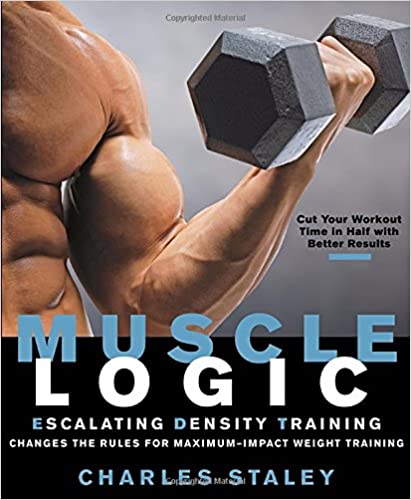Program Name
Escalating Density Training (EDT)
Price
Free
Author
Charles Staley
Primary Goal
Hypertrophy (though it can be strength, depending on how the rep schemes are structured)
Secondary Goal
Strength
Special Focus
None
Program Length (in weeks). Charles Staley recommends 4-6 weeks
Training Days (per week)
Average Session Length (in minutes). May vary, depending on warm ups.
Primary Equipment
Barbell (technically, really depends on exercise selection. The program can really be done with virtually any piece of equipment).
Specialty Equipment
None (though the more equipment, the better for varying exercise selection)
Novice Friendly?
Yes (it can be done with bodyweight or machines; Staley recommends inexperienced lifters use machines when starting off)
Prerequisite Skills
None, however, for those not using machines, proficiency in compound lifts (back squat, bench press, deadlift, etc) is required.
Other Key Points
In EDT, the focus isn’t on set volume, but rather on the total work done during each session (which is technically volume in and of itself); in this case, the total number of reps completed at a specific weight for the set period of time.
In the traditional application, each workout consists of a breed of two 15 minute supersets (called “PR Zones”). The trainee floats back and forth between two compound exercises (isolation/auxillary work can also be added), and completes up to five reps of each exercise per “set” (bout within the PR Zone), using their 10 RM (10 rep max; a load that they can complete for 10 reps in a normal set). As fatigue sets in, the expectation is that five reps will likely drop to four, three, and so on until the 15 minutes is up.
When the trainee breaks their previous PR Zone record (total number of reps they complete in 15 minutes) by 20% (e.g., if 48 reps were completed in the current session, when 40 were completed the week before), they add 5-10 lbs to the bar for the next workout, and repeat the process. If they miss their total reps by 20%, they remove 5-10 lbs from the bar. The primary goal of every workout is to push yourself to beat your previous PR Zone rep count, regardless of whether or not you hit five reps every time, or a mix of reps (five, four, two, etc).
The trainee is encouraged to pair antagonistic (opposing) muscle groups when choosing their exercise selection. This maximizes the potential for more workload, and also touts a training effect for anaerobic work capacity. For instance, barbell rows could be paired with dumbbell bench press. Here is a list of exercise pairings suggested by Staley in his T Nation article, “Going Deep with EDT”:
Upper Body
- Bench Press/Chins
- Low Cable Row/Barbell Military Press
- Lat Pulldown/Triceps Pushdown
- Close-Grip Bench Press/Bent Rows
- Standing Barbell Curl/Lying Dumbbell Triceps Extension
- Floor Press/Reverse-Grip Cleans
- Push-Up/Pull-Up
- Lateral Raise/Cable Arm Adduction
- Straight-Arm Pulldown/Plate Raise
Lower Body
- Leg Extension/Leg Curl
- Front Squat/Back Extension
- Seated Calf Raise/Tibealis Curl
- Hip Abduction/Hip Adduction
Full Body
- Back Squat/Chins
Front Squat/Dips
Deadlift/Floor Press
Overhead Squat/Clean Pull
Muscle-Up/Power Clean
Back Extension/Ball Crunch
Though 10 RM is recommended when starting (with hypertrophy being the primary goal), 6 RM (for strength), 20 RM (for endurance) and virtually any other load can also be used.
A rest period of 5-10 minutes between PR Zones is recommended. Rest between exercises during the 15 minutes is up to the discretion of the lifter.
Though 40-60 reps per exercise per PR Zone is typical, Staley enourages trainees to not focus on those arbitray targets, but instead, work to beat their previous record.
The program can be run indefinitely and as often as the trainee feels comfortable, however, Staley recommends 3-5 days/week for 4-6 weeks (many folks who have run the program report significant fatigue after a month of trying to best themselves week after week…myself included). Upon completion of the program, trainees can either repeat the cycle with new exercises, or switch to another program entirely.
Visit the link below to sign up for a free 92 page issue of MASS Research Review (you can read my MASS review here) covering the following topics:
- Blood Flow Restriction Training Causes Type I Fiber Hypertrophy in Powerlifters
- Leave the Gym with a Little Left in the Tank
- Energy Availability in Strength and Power Athletes
- Hormonal Contraceptives Don’t Mitigate Strength Gains
- Power Training or Speed Work for Some, But Not All?
- The Role of Physical Activity in Appetite and Weight Control
- The Science of Muscle Memory
- VIDEO: Program Troubleshooting
- VIDEO Sustainable Motivation for Sport and Fitness
Resources
- Escalating Density Training Revisited (Charles Staley’s outline of the program on T Nation)
- Going Deep with EDT (Staley’s program FAQ on T Nation)
- EDT for Strength (Derek Woodske’s application of the program for heavy lifting and athlete training)
- Muscle Logic: Escalating Density Training (Charles Staley’s book on the program)

